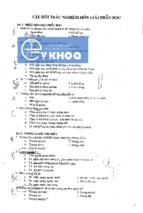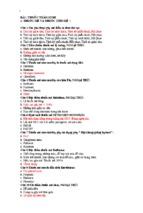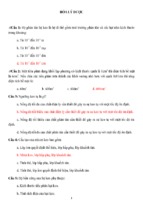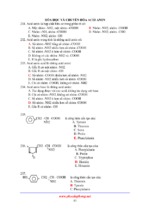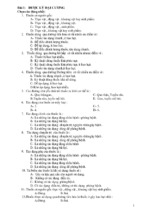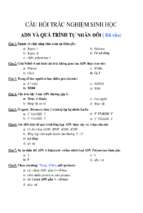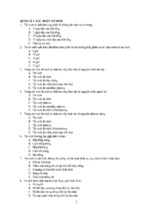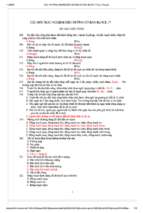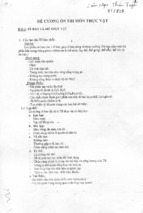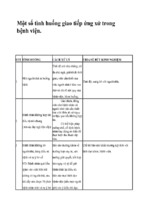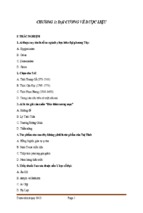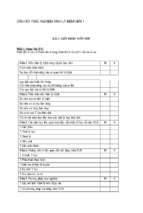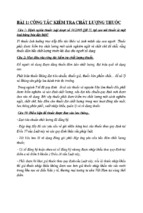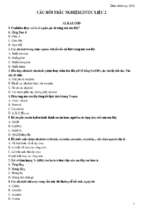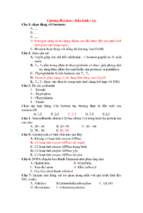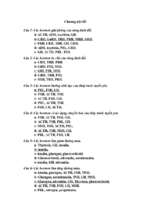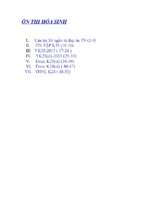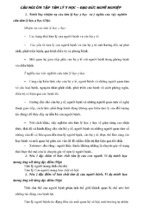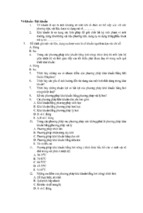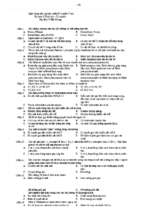Mô tả:
ENGLISH EXERCISE
A- THE DIGESTIVE SYSTEM
1) Which of the following is NOT a function of saliva?
a. to aid in cleansing the teeth
b. to lubricate the pharynx
c. to initiate protein digestion
d. to assist in the formation of a bolus
2) Formation of gallstones is referred to as
a. hepatitis
b. jaundice
c. cholelithiasis
d. cirrhosis
3) The part of the stomach that meets the esophagus
at the gastroesophageal sphincter is
a. the cardia
b. the pylorus
c. the lesser curvature
d. the fundus
4) Teeth adapted to shear food are
a. incisors
b. molars
c. premolars
d. canines
5) The terminal portion of the small intestine is
a. the ileum
b. the cecum
c. the jejunum
d. the duodenum
6) Peristalsis moves food material
a. in the intestines only
b. from the pharynx to the anal canal
c. in the stomach and small intestine only
d. in the stomach and intestines only
7) Obstruction of the common bile duct by gallstones
would most likely affect the digestion of
a. nucleic acids
b. proteins
c. fats
d. carbohydrates
8) The hepatic flexure of the large intestine occurs
between
a. the descending colon and rectum
b. the ascending colon and transverse colon
c. the transverse colon and descending colon
d. the cecum and ascending colon
9) Which structure controls the flow of food and water
from the stomach to the small intestine?
a. pyloric sphincter
b. ileocecal valve
c. cardiac sphincter
d. pyloric valve
10) which term means difficulty in swallowing?
a. pyrosis
b. dyspepsia
c. anorexia
d. dysphagia
11) Which condition is a protrusion of part of the
stomach through the diaphragm?
a. inguinal hernia
b. esophageal varices
c. gastrocele
d. hiatal hernia
12) Put the anatomical structures in order from when
food first enters the body
Teeth Pharynx Esophagus Stomach Small intestine Large intestine
Rectum
13) Which tube leads towards the stomach and carries
food? (Esophagus)
14) The ____________ sphincter separates the
stomach from the small intestine. (pyloric)
15) Saliva begins to ____________ the food as it is
ground and cut by the teeth (Digest)
16) The swallowing reflex is stimulated by
a. Food in the larynx
b. Food in the pharynx
c. The pharynx
17) The peristaltic wave reaches the pyloric sphincter,
which makes food enter the stomach: False
18) Which organ does most of the digestion and
absortion of food?
a. Small intestine
b. Large intestine
c. Liver
d. Stomach
B- THE CARDIOVASCULAR SYSTEM
19) Match the terms with their definitions
20) The systemic circuit pumps blood to the lungs.
False
21) An artery is a vessel that carries blood back to the
heart: False
22) Diastole is the relaxation phase of the heart cycle:
True
23) The left ventricle pumps blood into the aorta: True
24) The brachial artery supplies blood to the leg: False
25) The bicuspid valve is also called the mitral valve:
True
26) Bradycardia is a lower than average heart rate:
True
27) The outermost of the three layers of the heart is
________
a. the endocardium
b. the pericardium
c. the epicardium
d. the supracardium
28) The correct sequence for blood entering the heart
through the venae cavae and leaving through the aorta
is
a. right atrium, left atrium, left ventricle, right ventricle
b. left atrium, left ventricle, right atrium, right ventricle
c. left ventricle, left atrium, right ventricle, right atrium
d. right atrium, right ventricle, left atrium, left ventricle
29) The heart is covered by ___________
a. the supracardium
b. the epicardium
c. the pericardium
d. the endocardium
30) Which occurs during systole?
a. atrial filling
b. atrial relaxation
c. ventricular filling
d. ventricular contraction
31) The heart lies in the ________ cavity.
a. ventral pericardial
b. ventral pleural
c. dorsal mediastium
D. Dorsal pericardial
32) The opposite meaning of the following word:
hypercapnia
Hypocapnia
33) The opposite meaning of the following word:
inspiration
Expiration
34) The opposite meaning of the following word:
tachypnea
Bradypnea
35) The opposite meaning of the following word:
intubation
Extubation
36) The opposite meaning of the following word:
hypopnea
Hyperpnea
37) Inspection or examination of the bronchi:
Bronchoscopy
38) Swelling of the mucosa of the bronchi:
Bronchoedema
39) Dilatation of the bronchi:
Bronchiectasis
40) The flushing out of the pleural cavity:
pleuroclysis
41) Incision into the pleura:
Pleurotomy
42) Herniation of lung tissue or of the pleura:
Pleurocele
43) Fungus infection of the nose:
Rhinomycosis
44) Pain in the nose or nasal area:
Rhinodynia
45) Abnormally fast rate of breathing:
Tachypnea
46) Increase in the depth and rate of breathing:
Hyperpnea
47) Retarded or small amount of breathing:
Oligopnea
48) A deformity of the chest:
Thoracocyllosis
49) Examination of the chest:
Thoracoscopy
50) Surgical punture or tap of the chest
Thoracentesis
C- Circulatory System
51) According to the recording, your heart is
a. acts as a pump.
b. is located in the right center.
c. is not a muscular organ.
d. bigger than your fist.
52) What is the function of the division?
a. To help the body fill with oxygen-rich blood
b. To separate the two types of blood
c. To protect oxygen-poor blood
d. To separate the heart into two parts
53) What is the cardiovascular comprised of?
a. Blood
b. All are correct.
c. Oxygen-rich blood and oxygen-poor blood
d. The heart and blood vessels
54) Another name for “oxygen poor blood” is
......blood, and “ ....... ......... blood” is red blood.
55) Which blood circulates through the body, and then
returns to the heart? (Fill in each blank with ONE
word.)
-> .......blood
56) When blood is pumped into the lungs, what
happens?
a. The blood is supplied with oxygen.
b. The lungs turn red.
c. The lungs refresh the pulmonary arteries.
d. The blood has a new supply of blood.
57) What organs does the “new” blood supply - with
oxygen?
a. Tissues
b. None is correct.
c. Ventricles
d. Atria
58) What function do the four valves work as?
a. As gates
b. As a fence with gates
c. As fence
d. As gates on a fence
59) How do they work?
a. They open and close immediately.
b. They open when they are pushed on.
c. They close, and then open.
d. The open automatically.
60) (Fill in the blank with ONE word.) Each valve opens
and closes one time per ....... .
61) (Fill in each blank with ONE word.) Systole is the
name for “....... ”, and diastole is for“............”.
62) During the first step, what happens?
a. Blood is forced into the lungs and body.
b. The ventricles push the blood into the lungs and body.
c. The right ventricle contracts, and the left one relax.
d. The ventricles contract.
63) What comparison does the speaker make?
a. blood like the ketchup and the lungs like squeezed bottles
b. the lungs like the ketchup and the body like a squeezed bottle
c. None is correct.
d. blood like the ketchup and the heart like a squeezed bottle
64) Which ventricle contracts first, and which one
later?
→ The ......one, and then the ........ one.
65) After the ventricles relax, what happens?
a. They take blood from the lower chambers.
b. All are correct.
c. They are filled with blood from the atria.
d. They start the diastole period.
66) What are capillaries?
a. Blood vessels that divide into the branches.
b. Coronary arteries that extend over the surface of the heart.
c. Neither is correct.
d. Both are correct.
67) What is the function of the electrical wiring
system?
a. It travels to the ventricles.
b. All are correct.
c. To give signals of pumping blood.
d. It goes to a specialized pathway.
68) What keeps blood circulating?
a. The coordination and normal rhythm of heart beats
b. Both are correct.
c. Neither is correct.
d. The conduction system
69) People would die if there were
a. no exchange of the two types of blood.
b. the same amount of the two types of blood.
c. more oxygen-poor blood than oxygen-rich blood.
d. no oxygen-poor blood.
- Xem thêm -

